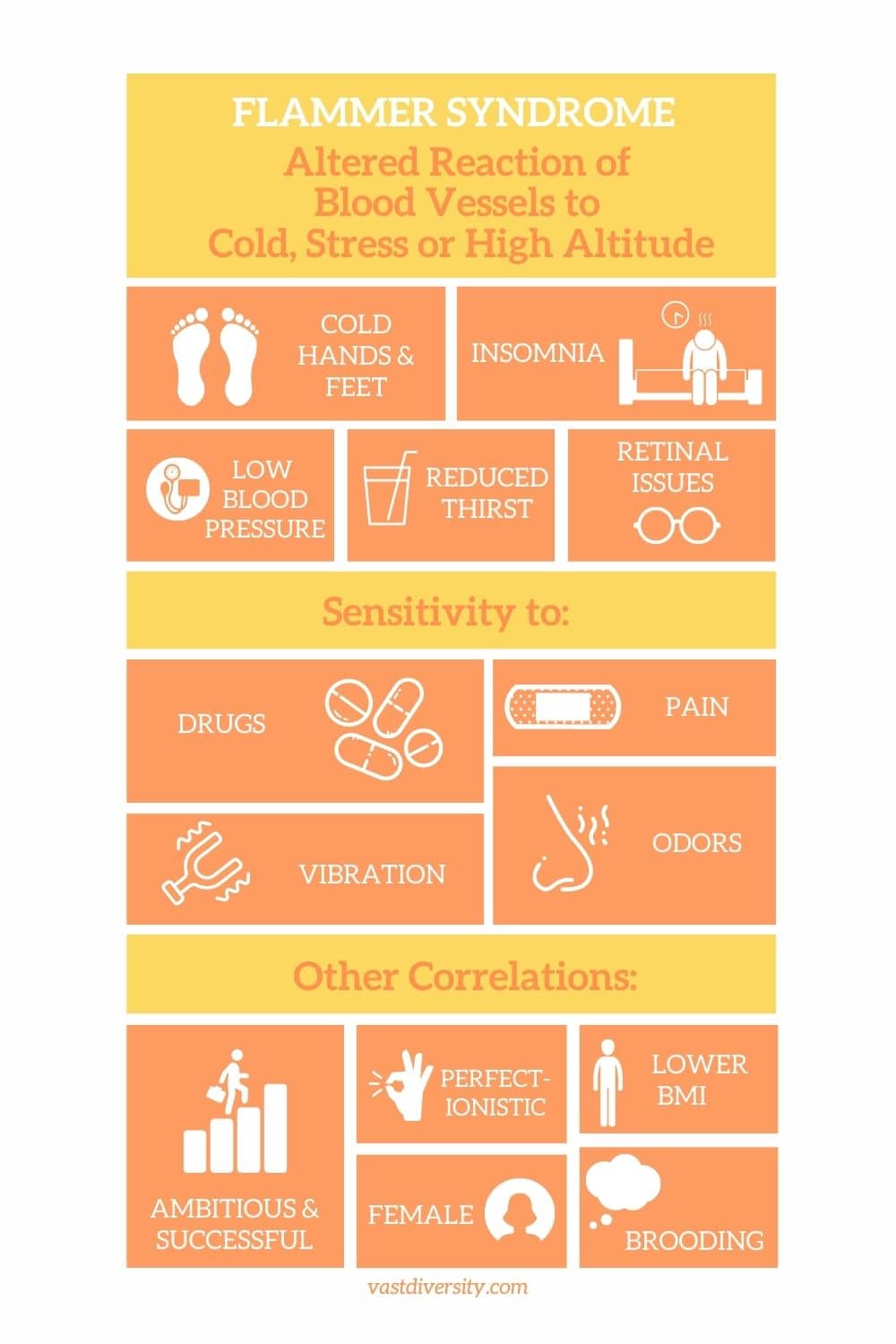I’ve always had cold hands and feet. Like really cold hands, make people scream cold. And icy feet that take forever to warm up once I get into bed at night.
I’ve discovered that freezing hands and feet are the signature feature of Flammer Syndrome, which links cold hands and being a highly sensitive person. Or…. as they say… Cold hands, warm heart.
Read on to learn about Flammer’s Syndrome, and possible treatment for some of these linked symptoms. (I was shocked to discover I have 10 of the 14 most common symptoms!)
What Does Flammer Mean?
This all started when Dr. Flammer, an ophthomologist, noticed that a lot of his patients had freezing cold hands.

Instead of ignoring this interesting fact, Dr. Flammer wondered what this might mean.
He tested one patient and realized she had vasospasm in her fingers when they were cold. Vasospasm is when arteries constrict, which causes a shortage of blood supply to the body part affected.
Dr. Flammer thought ‘Hmmmm….I wonder if it is also vasospasm in her eyes causing her eye condition (normal tension glaucoma)?’

The idea that this form of glaucoma could be caused by vasospasm was considered ridiculous at the time by the medical community.
Dr. Flammer ignored the naysayers and spent years researching his patients with cold hands. It is now understood that certain types of glaucoma are linked to vasospasm.
But… he also discovered that his ‘shockingly cold hands’ patients shared other traits. ‘Flammer Syndrome’ describes people having these traits..
What is Flammer Syndrome?
Flammer syndrome is a constellation of symptoms due to blood vessel dysregulation. The blood vessels react differently to stimuli like coldness, emotional stress, or hypoxia.
Symptoms include cold hands and feet, insomnia, low blood pressure, reduced thirst, increased sensitivity certain stimuli, various retinal issues and other physical and psychological correlations.

Flammer Syndrome vs Raynaud’s Disease
Flammer syndrome is different from Raynaud’s disease. While patients with Raynaud’s disease also have cold hands and feet that respond to the cold and stress, Raynaud’s is more rare and more severe than Flammer Syndrome.
People with Raynaud’s can have a severe lack of oxygen to the skin, due to a more extreme blood flow decrease in the extremities. The skin turns white or blue, and when the blood flow returns the skin turns red and can throb or tingle.
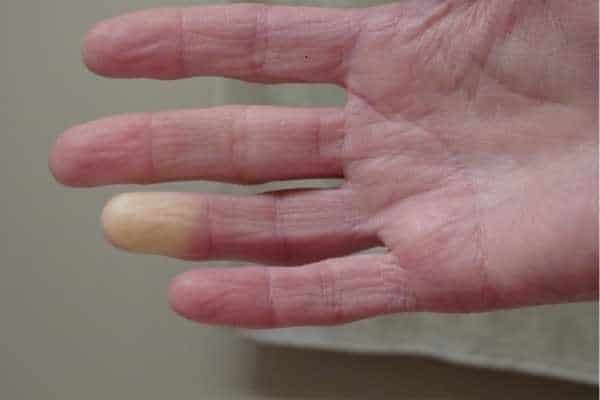
Raynaud’s disease can even result in sores or death of the tissue.
With Flammer Syndrome there can be pale extremities but not as severe a reaction as can happen with Raynaud’s.
The skin with Flammer Syndrome is more mottled and looks more like this picture:
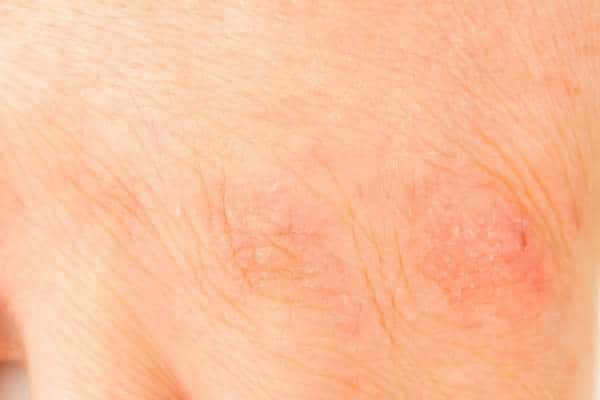
Flammer syndrome also has many other symptoms not related to Raynaud’s Disease.
Low Blood Pressure, Cold Hands and Feet
Flammer Syndrome is having a dysregulation of blood vessels which makes them react differently to various types of stress.
Since blood flow is important for the function of the body, it shouldn’t be a surprise that having dysregulation of blood vessels would cause various effects in the body.
And, they found differences all right, all sorts of differences….
The most common traits of Flammer Syndrome are shown in this diagram:
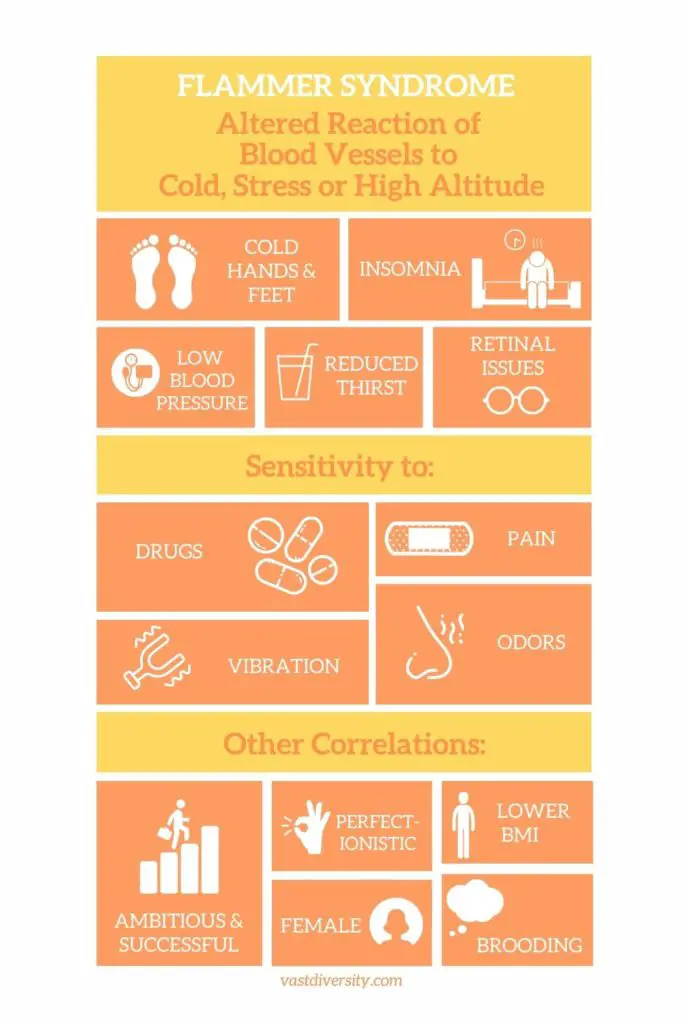
How many of these traits do you have? I have 10/14 that I am aware of!
Let’s go through a few of these traits in more detail.
Flammer Syndrome: Cold Hands and Feet Syndrome
Dr. Flammer noted ‘when shaking hands with a patient, cold hands were often a striking symptom’.

To study the reason for these cold hands, they used a ‘cold provocation’ test. This helped them to scientifically proved that these patients had vasospasm when exposed to cold temperatures.
But even without being exposed to the cold there was a difference. Patients also had a temperature difference between the foot and the upper leg during the day. This difference disappeared during sleep and was not related to the menstrual cycle.

Another interesting observation: skin blotchiness which worsened under emotional stress.
Flammer Syndrome: Insomnia
Patients with Flammer syndrome had insomnia, specifically difficulty falling asleep. In scientific terms: prolonged sleep onset time.

They also reported being ‘evening persons and had circadian rhythm delay of 1hr on average.
Flammer Syndrome: Low Blood Pressure and HRV
People with Flammer Syndrome seem to have low blood pressure.
They found that the low blood pressure could normalize with age. And that the patients may have orthostatic hypotension (blood pressure dropping when you stand up).
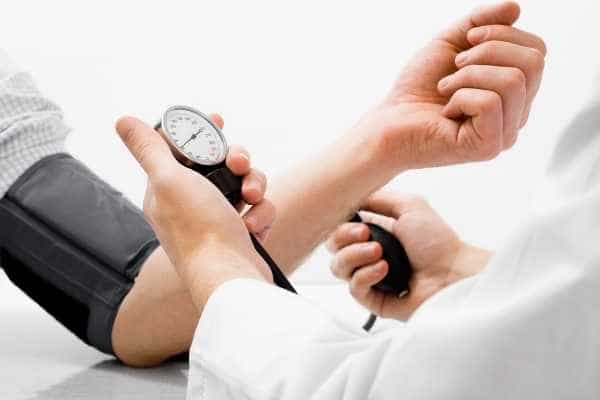
They also found that people with Flammer Syndrome had an autonomic imbalance with sympathetic predominance and lower heart rate variability. These are both indicators of stress.
Flammer Syndrome: Reduced Feeling of Thirst
So this seems like an odd symptom, but I admit I have it. The patients told Dr. Flammer that they drank not due to thirst but because they knew they had to drink.

It is speculated that this reduced thirst sensations may be caused by the increased level of endothelin-1, a hormone which is involved in vasoconstriction.
Most patients also noted that they often had muscle cramps.
Flammer Syndrome: Normal Tension Glaucoma
If you recall, Dr. Flammer was an opthomologist who noticed lots of his patients had cold hands.
When he studied this group of patients he discovered that Normal tension glaucoma can be caused by poor ocular blood flow.

He found that even people with Flammer Syndrome who had no eye disease did have a reduced ability to autroregulate ocular blood flow.
There has also been a link noted to increased stiffness of retinal vessels, and higher irregularities in retinal vessels.
Flammer Syndrome: Sensitivities
So obviously there is a sensitivity to cold (freezing cold hands and feet!).
In fact 3 of Dr. Flammer’s patients became unconscious when jumping into the cold water of the sea.

Many of his patients had increased smell perception. They identified odours significantly better than other people.

Some patients had an increased vibration sensitivity. One patient felt an earthquake when nobody did, and it turned out that she was actually right!
Another patient had become unconscious during a balloon ride. They surmised that she had increased sensitivity to the hypoxia which occurred during a balloon ride due to lower air pressure at high altitudes.

Not surprisingly, altitude sickness is more pronounced in people with Flammer Syndrome.
Many patients reported increased sensitivity to certain drugs. This might be due to a different expression of ATP transport proteins.
Dr. Flammer also noted that these patients had an increased sensitivity to emotional or physical stress.

This sensitivity to psychological stress in people with Flammer syndrome has not yet been studied scientifically.
Flammer Syndrome: Other Correlations
Through multiple studies, Dr. Flammer and his colleagues found a number of other correlations in people with Flammer syndrome:
- More often women
- Tinnitus
- Sometimes even sudden hearing loss which could improve

- Low BMI
- Intensified physical exercise, especially running and cycling

- Ambitious’, ‘often successful in their careers’
- More often academics
- Tendency towards perfectionism – ‘They tend to be very exact and diligent, particularly at work’

- ‘Brooding’ (which means sullenly thoughtful or serious)
- Increased rates of anorexia nervosa

Flammer Syndrome: Link to Other Medical Issues
In addition to those other correlations, people with Flammer Syndrome seem to be more at risk of having other medical issues.
Here are some of the medical correlations they found:
- Silent Myocardial Ischemia
- Headaches or migraines (often with visual aura)
- Tinnitus, sudden hearing loss, and even Ménière’s disease.
- Hashimoto thyroiditis
- Possible link to Multiple Sclerosis

Researchers also found that people with Flammer Syndrome had altered gene expression in lymphocytes (a type of white blood cell).
Flammer Syndrome Causes and Treatment
There is a lot of research going on into the causes of Flammer Syndrome and some of it actually explains some of the symptoms themselves!
Do you think you have Flammer Syndrome after going through the lists above? Wonder what it might mean and what you can do about it?
Treatment of Flammer syndrome involves three aspects, Lifestyle management, Nutrition and Drugs/Supplements. Read my next post on the causes anad treatment of Flammer Syndrome for more details but here is a treatment summary:
Lifestyle Management
- Recognize how your body feels when under stress, body scans are a good tool
- Find relaxation techniques that work for you. There are many many options like yoga, meditation, breathing techniques like physiological sighs, visualization techniques, Non-Sleep Deep Rest Protocols like yoga nidra or self-hypnosis, and polyvagal exercises.
- Sleep well, avoid stress, stop smoking, hydrate with electrolytes.

Nutrition
- An antioxidative diet, consider brain supportive supplements like Omega-3 fatty acids
- Salt or electrolyte tabs can help to increase blood pressure
Medication and Supplements
- Magnesium reduces vascular dysfunction, oxidative stress and retinal cell apoptosis (cell death). Magnesium also helps with peripheral circulation, so should help with the cold hands and feet.
- Ginkgo biloba extract has been shown to increase blood flow.
- CoEnzyme Q10 has been shown to reduce oxidative stress.
- Melatonin has an antioxidative role, you can increase melatonin levels with light exposure.
- A calcium channel blocker may help with circulation (doctor’s prescription required).

References
- The discovery of the Flammer syndrome: a historical and personal perspective
- Individualised patient profile: clinical utility of Flammer syndrome phenotype and general lessons for predictive, preventive and personalised medicine
- Diseases potentially related to Flammer syndrome
- Diseases associated with Flammer Syndrome: An Update
- The primary vascular dysregulation syndrome: implications for eye diseases
- Flammer syndrome
